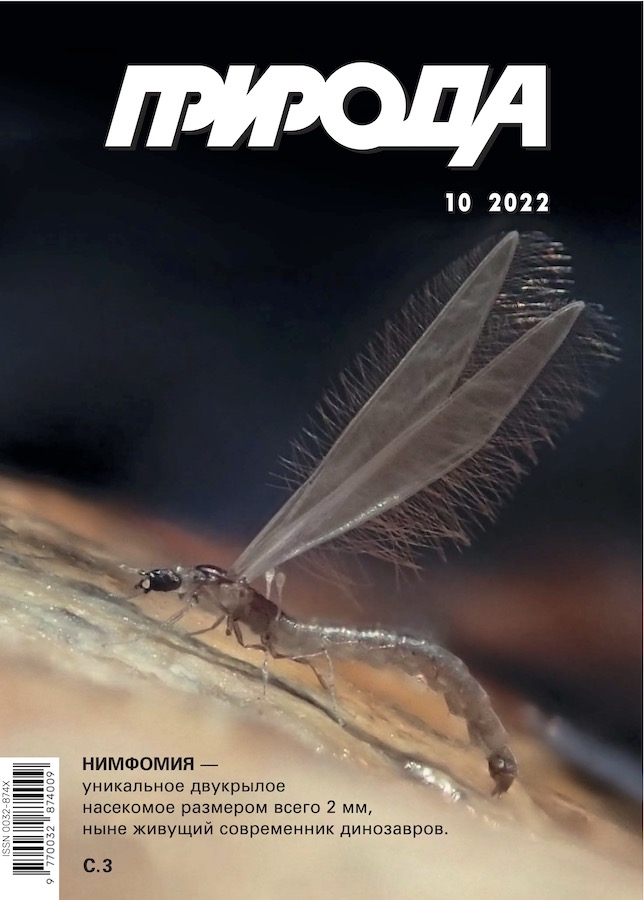Amazing Cyclidans — the Witnesses of the Great Extinction: Part II
- 作者: Mychko E.V1,2,3
-
隶属关系:
- Shirshov Institute of Oceanology, Russian Academy of Sciences
- Severtsov Institute of Ecology and Evolution, Russian Academy of Sciences
- Borissiak Paleontological Institute, Russian Academy of Sciences
- 期: 编号 10 (2022)
- 页面: 26-35
- 栏目: Articles
- URL: https://journals.eco-vector.com/0032-874X/article/view/627703
- DOI: https://doi.org/10.7868/S0032874X22100039
- ID: 627703
如何引用文章
详细
Cyclidans are a group of extinct crustaceans that remain enigmatic due to the rarity of their fossils. They inhabited both the water bodies with different salinity and fresh waters. Cyclidans were among the main components of the reef communities and settled on the practically dead seabed. Neither their ancestors nor the reasons for their extinction are known. The cyclidan morphotype allows us to consider their origin by analogy with the evolution of crabs from lobster-like ancestors and, on this basis, to suggest the appearance of their ancestral form.
作者简介
E. Mychko
Shirshov Institute of Oceanology, Russian Academy of Sciences; Severtsov Institute of Ecology and Evolution, Russian Academy of Sciences; Borissiak Paleontological Institute, Russian Academy of Sciences
Email: eduard.mychko@gmail.com
Moscow, Russia; Moscow, Russia; Moscow, Russia
参考
- Mychko E.V., Feldmann R.M., Schweitzer C.E., Alekseev A.S. New genus of Cyclida (Crustacea) from Lower Carboniferous (Mississippian, Viséan) of Russia and England and new species of Viséan of Russia. Neues Jahrbuch für Geologie und Paläontologie — Abhandlungen. 2019; 294: 81–90. doi: 10.1127/njgpa/2019/0847.
- Woodward H. Contributions to British fossil Crustacea. Geological Magazine. 1870; 77: 493–560.
- Mychko E.V., Alekseev A.S. Two new genera of Cyclida (Crustacea: Maxillopoda: Branchiura) from the Cisuralian (Lower Permian) of Southern Urals. Neues Jahrbuch für Geologie und Paläontologie — Abhandlungen. 2018; 289: 23–34. doi: 10.1127/njgpa/2018/0747.
- Gemmellaro G.G. Crostacei dei Calcari con Fusulina della Valle del Fiume Sosio nella Provincia di Palermo in Sicilia. Memorie della Societа Italiana delle Scienze. 1890; 8(3/1): 1–40.
- Bakel B.W.M. van, Jagt J.W.M., Fraaije R.H.B., Artal P. A new family, genus and species of cyclid (Crustacea, Branchiura, Cyclida) from mid-Cretaceous reefal deposits in northern Spain. Bulletin of the Mizunami Fossil Museum. 2011; 37: 47–49.
- Schweigert G. Juracyclus posidoniae n. gen. and sp., the first cycloid arthropod from the Jurassic. Journal of Paleontology. 2007; 81(1): 213–215.
- Raczynski P., Biernacka J. Zechstein in Lithuanian — Latvian Border Region. Geologija. 2014; 56(2–86): 57–62.
- Clements T., Purnell M., Gabbott S. The Mazon Creek Lagerstätte: a diverse late Paleozoic ecosystem entombed within siderite concretions. Journal of the Geological Society. 2019; 176: 1–11. doi: 10.1144/jgs2018-088.
- Dzik J., Sulej T. A review of the early Late Triassic Krasiejów biota from Silesia, Poland. Palaeontologica Polonica. 2007; 64: 3–27.
- Ruppert E.E., Fox R.S., Barnes R.D. Invertebrate Zoology: A Functional Evolutionary Approach. Belmont. 2004; 3.
- Пономаренко А.Г. Артроподизация и ее экологические последствия. Экосистемные перестройки и эволюция биосферы. Вып.6. М., 2004; 7–22.
- Татаринов Л.П. Морфологическая эволюция териодонтов и общие вопросы филогенетики. М., 1976.
- Пономаренко А.Г. Ранние этапы эволюции членистоногих. Жерихин В.В., Пономаренко А.Г., Расницын А.П. Введение в палеоэнтомологию. М., 2008.
- Borradaile L.A. Crustacea. Pt.II. Porcellanopagurus: An instance of carcinization. British Antarctic (“Terra Nova”) Expedition, 1910. Natural History Reports: Zoology. 1916; 3(3): 111–126.
- Stevcic Z. The main features of brachyuran evolution. Systematic Zoology. 1971. 20: 331–340.
- Keiler J., Wirkner K.S., Richter S. One hundred years of carcinization — the evolution of the crab-like habitus in Anomura (Arthropoda: Crustacea). Biological Journal of the Linnean Society. 2017. 121: 200–222. doi: 10.1093/biolinnean/blw031.
- Wolfe J.M., Luque J., Bracken-Grissom H.D. How to become a crab: Phenotypic constraints on a recurring body plan. BioEssays. 2021. doi: 10.1002/bies.202100020.
- Schweigert G. The first cycloid arthropod from the Late Jurassic. Zitteliana: Series A. 2006; 46: 85–89.
- Fraaije R.H.B., Krzeminski W., Bakel B.W.M. van et al. A new type of pylochelid sixth abdominal tergite (Anomura, Paguroidea) from the Upper Jurassic of Poland. Scripta Geologica. 2014; 147: 21–25.
- Stolley E. Über einige Brachyuren aus der Trias und dem Dogger der Alpen. Jahrbuch der Kaiserlich-Königlichen Geologischen Reichsanstalt. 1915; 64: 675–682.
- Hyzný M., Haug C., Haug J.T. Mesoprosopon triasinum from the Triassic of Austria revisited: the oldest eumalacostracan larva known to date and its significance for interpreting fossil cycloids. Gondwana Research. 2016; 37: 86–97. doi: 10.1016/j.gr.2016.05.010
- Пирожников Л.П. Остатки Cycloidea из отложений казанского яруса реки Кожим (Печорский каменноугольный бассейн). Сборник статей по палеонтологии и биостратиграфии. Вып.17. Л., 1960.
补充文件








